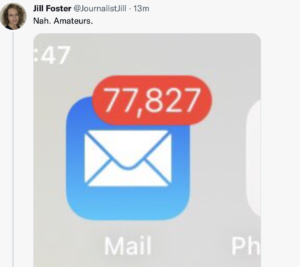
I’m sure I’m not alone in loathing those follow up calls from PRs asking, ‘Have you seen my email?’
And when I’m talking to organisations about media messaging and strategies the one constant is their surprise at how many emails journalists receive, and never read.
That said, I do try to purge the pointless press releases, hold the dates, and announcements about new clients at regular intervals. Indeed, ’emails down to…’ is a regular item on my to-do lists.
 But recently, when I shared this screengrab showing 12,964 unread emails, I discovered I’m not even close to being in the leave-them-to-pile-up league.
But recently, when I shared this screengrab showing 12,964 unread emails, I discovered I’m not even close to being in the leave-them-to-pile-up league.
Methinks my friend, the fabulous feature writer, Jill Foster must hold the record… or does she? Would be fascinated to get an average, so please share via comments or social media.
Advice to PRs
And to any PR — or more importantly the client of a PR or comms agency — who is reading this, we’re busy. We get sent tsunamis of uninteresting, poorly written, and ineptly targeted press releases.
Be like Coco Chanel, less really is more. And ‘don’t spend time beating on a door, hoping to transform it into a door’.
Before the pandemic we surveyed MJA members on pet hates and pluses, and developed these guidelines for members of the Healthcare Communications Association. If you work in PR or comm’s, they will help you avoid the most common pitfalls (italics at the end are from HCA, but will also reduce the chance of being among the 12,963 or 77,827):
- Ensure the story you are pitching is relevant to the journalists own area of interest
Journalists report their biggest pet-hate is pitches for stories which are not appropriate for their subject or regular outlets. Of concern is the fact that journalists say that only around 10% of the press releases and pitches they receive are relevant to their work. As well as blocking inboxes and wasting journalists’ time this damages the reputation of the communications sector and numbs journalists to approaches in general.
- A short email outlining the idea and story elements available is journalists’ preferred approach
Email is the universally preferred approach with brevity being the most important factor for around 90% of journalists. It is important to note that follow-on calls to ‘check a press release has been received’ or find out ‘when the story is being used’ are journalists’ second biggest pet hates.
- Ensure your story is clearly outlined in the headline and first paragraph of an email / press release
It will be no surprise that most journalists do not read every press release or email they receive. And when they do they rarely read a press release to the end, with many only reading the headline and first paragraph at most.
- If they are interested, journalists will want rapid access to the full story or paper, preferably ahead of time under embargo
Be ready. Professional journalists will respect embargoes if they agree to them. Giving a journalist time to prepare a story maximises the opportunity for them to present it in a format most likely to be published. If you offer an exclusive, ensure it is exclusive and be honest about which other media outlets have been approached and promised. Some don’t mind a story appearing in a non-competing outlet, but they do mind not being asked if this is OK.
- Spokespeople need to be credible and available
The right company spokesperson can be of interest, but most journalists will want credible, independent spokespeople. In all cases, these individuals need to be available in the journalist’s timescales, not theirs. They also need to be prepared to be interviewed on the subject and not expect pre-prepared questions or to have a communications colleague ‘listen-in’.
Following this guide in approaching health journalists with media stories will help ensure, as a sector, healthcare communicators are seen as professional colleagues who appreciate the needs and work demands on health journalists. In turn, this can help ensure health journalists remain receptive to healthcare communicators, knowing what they provide will be appropriate, considered and of potential media value.
.



Recent Comments